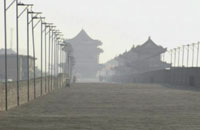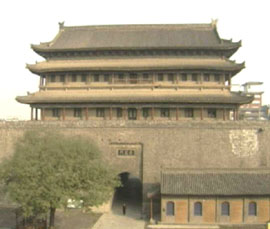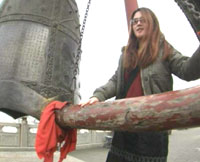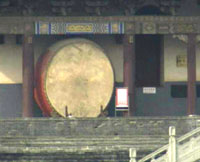Source: CCTV.com
08-15-2006 14:14
------the capital of the middle kingdom In golden era cctv.com 12-02-2005 14:50
Hi, welcome to travelogue. I am Yanling. I am taking you to my dream city to live in if I were 1400 years younger!
 | |
The camels are clustered right outside of the city wall, waiting for being loaded up with ceramics, scrolls of paintings, cascades of silk and texture in all colors to take on the western journey.
Inside the city, merchants are getting ready to bargain and fill their stores with lastest imports—exotic spices, persian instruments, Syrian latest fashion… this is the yearning centre for so many people, the cosmopolitan city of grand Tang Dynasty—Changan!
 | |
The city that sits on this ancient site today is called Xi’an, served as the capital city for 13 dynasties in Chinese history. Let’s take a trip back to one of its most glorious time--- Tang Dynasty! Welcome to Xi’an
“Good fortune falls on the golden-pillared gateway…
Upon supreme prophecies of emperor Taizong
The empire is solid as mountain and reaches the sky”
--- Du Fu, Poet (712-770 Tang Dynasty)
Together with Athens, Rome and Cairo, Xi’an is acclaimed as one of four leading and still living capitals of ancient civilizations in the world.
Served as the capital of 13 dynasties for an aggregate time of over a millennium. The city itself is a living museum, an open history book, an archeologist Toyland.
It was from here, in 139 B.C. that envoy Zhang Qian set out on his long journey to the west that opened the Silk Road, which extended at its longest during Tang Dynasty, when Chinese ancient civilization is considered reached its most glorious。
As the centre and symbol of this glory, Changan magnified artists, poets, travelers, scientists, merchants and foreign students from all over the world.
Constant exposure and exchange of new ideas and concepts nurtured an unprecedently open and culturally tolerant city. Nothing could make a real Chang aner easily raise his eyebrows: Daring fashion, interracial marriage, or even have an empress reign the empire…
It was the best of the time, and Changan just was the best place to be, for everyone!
Today’s city wall was rebuilt 600 years ago based on Tang Dynasty structure. Standing at 12 meters tall, stretching over more than 13km, it is a monument of Xi’ an’s history itself.
As the most important city fortification in ancient time, the city wall circled the entire inner city in a rectangular shape, with only 4 gates opening up in 4 directions controlling all comings and goings.
 | |
As military fortress, top of the city wall was stationed by soldiers and no commoners were ever allowed to stroll around. Time has definitely changed for better in this perspective—tourists are not only allowed to walk through the passage that used to be reserved only for the emperor, but also can go for a easy tour in a luxury a military officer on duty could not ever imagine…
I would imagine most people come to Xi’an for its history like I do, but in the middle of the city, or more accurately on the top of it, it is hard to ignore the city’s mobile energy that gestated under its ancient look, its strong modern pulse bumping under earth.
Today’s Xi’an population exceeds 6 million, the urban plan inherited from as early as Tang dynasty makes the city look more orderly than most provincial city I have ever been to.
 | |
 | |
According to Chinese tradition, a drum tower and a bell tower are to be built side by side in the city center to report time. The bell is ring by dawn and drum by dust.
Xi’an was the first city in the world to introduce urban planning, with grid pattern, straight roads running north- south and east west
 | |
The grids created by streets were designed to meet at right angel, epitomizing the traditional Chinese aesthetic concept of balance and harmony.
The population of Changan exceeded 2 million at its most prosperous in Tang Dynasty, it was the world capital of its time by any standard…
For fortune, adventure, career opportunities, or just the refined life style, people from all over the world flock to Changan through the silk road.
 | |
But there are also others who chose to do the opposite, leaving the city of opportunity searching for personal spiritual enlightment. Monk Xuan Zang is perhaps the most famous one among them..
Tang Dynasty’s cultural florescence in part has to thank to the fact that chang an became the Buddhist learning center, and monk Xuan Zang made Changan the place where Buddhism flourished…
 | |
Monk Xuan Zang, better known as the “monk from Tang” in folklores was also a devoted translator and traveler in the history. At the age of 28 in 627 AD, he set off alone for the quest to India, the Buddhist holy land.
He went through more than 130 kingdoms and states on the road, learned Buddhism in India and brought back thousands of Buddhist scriptures home to chang an after 18 years journey.
He stayed in this Cien monastery for 12 years working as abbot, translated Indian Sanskrit from to Chinese.
Buddhism came to China through Silk Road in Han dynasty, 600 years prior to Tang. As a foreign cultural import, it also went through a process of localization, and eventually evolved into the national religion during Tang Dynasty. The big goose pagoda is an example of this adaptation: Original Indian stupa was built in the form of square pyramid, catering to the Chinese aesthetics tradition.
 | |
Like the Lion King in the west, Monkey king is perhaps the most human character in Chinese mythology
The legend goes his sharp eyes can see through terrible forces of evil in every shape and size, and his bravery and magic can defeat them all.
He is truly love be all! The young admire his flying magic and his rebellion attitude towards authority. The elderly might find their own consolation in monkey’s frustration of being misunderstood even by his own master, and still manage to keep the faith and reached his goal….
Famen temple has the reputation of being the forefather of pagodas and temples in central Shaanxi province.
The influence of Tang Dynasty of China to Japan was profound.
Japan sent envoys and students to Yang Changan regularly. As the most advanced and prosperous city in the world, Changan was also the least discriminating place to foreigners in the world history. At many governmental institutions, foreigners enjoy equal career opportunities as local Chinese.
Of course still most of students went back home, in hope of building a reformed Japan modeled after Tang China.
Architecture is one of the most important Chinese exports to Japan. Today, the best preserved architecture of Tang style is to be found in Naro and Kyoto, of course naturally in smaller scale than Tang Changan.
The palace found under this pagoda is 21.2 miters long with 4 continuous blocks found full of valuable relics tribute by Tang emperors personally. The palace is only 1.2 meter high. So it suggests that even emperors have to climb in by knees, --that’s probablely the only time when a grand Tang emperor stays such a low profile…
And it could also be the only opportunity in an emperor’s life time--The palace used to be only opened every 30 years, in a strict Buddhist ritual, for the emperor in power paying respect to the budda’s finger bones.
The underground palace have never been excavated or robbed before the discovery nearly 20 years ago. Its relics boast as the largest of the kind, more than 2000 pieces of the most valuable treasure of the most glorious time.
But for Buddhists in the world, it is the remains of finger bones of Buddha that separates Famen temple from any other temples in China. It is said for a buddists, seeing this is almost like catching a glimpse of the shadow of the Buddha.
The Tang Empire extended from Turkish city states in the west, to Japan in the east, from Siberian in the north to Vietnam in the south, covering more territory than Alexander the Great, and the Roman Empire. Within the Tang Dynasty's centuries-long prosperity, 50 years can be accredited to one woman - Wu Zetian
Famous for her beauty and intelligence, Wu Zetian was chosen to the imperial court as concubine at age of 14, lived till 82, and held power for more than 50 years.
As the only empress in China’s entire history, she was known as hardworking, sagacious, but also ruthless and good at political intrigue.
She was initially helping Qian Ling is the only imperial tomb shared by 2 emperors—Wu Zetian and her husband Emperor Gaozong, with whom she ruled the country jointly before he died.
It is not very surprising considering the Tang Dynasty’s open social climate…
I would simply believe that she was one of the rare clear- headed monarch who could accept that -- merits or demerits, history has its own verdict.
The achievements of Wu Zetian's reign and her predecessors were carried forward and further developed, eventually brought the Tang Dynasty to the peak of its Kaiyuan splendor.
It was only the time like Tang Dynasty that could offer a stage for a woman like Wu Zetian, and her achievement in turn help to enhance the position of women in the society.
At some point, she even employed scholars to write biographies of famous women, served as a reminder to everyone what she herself proved to be that women were every bit as capable of men, plus most of the time, more beautiful.
And this is the most famous beauty representing that standard. Yan Yuhua, concubine to Emporor Xuanzong, is known as one of China’s famous 4 beauties over the history, probably the plumpest one.
Emperor Xuanzong rebuilt this palace dedicating to her as one of the attempt winning her heart. He was believed to fall in love at the first sight, although he was 30 years senior and was her father in law at that time.
The emperor of course got what he wants eventually and the couple spent most winter months here.
Take a bath.
In Chinese legends she was described as the woman only has a full and sensual figure, but also a woman with perfect skin, before the time of brand lotion, hotspring in her Huaqing palace is said to be the secret of that.
That became the eternal note of this love story.
The warm water slipped down,
Her glistening jade like body
At once she won the emperors favor…
Behind the warm lotus lower curtain…
1/6 of foreign tourists coming to China come to Xi’an, the second “must see” place after Beijing, although package tours mostly likely only includes a couple of days stay in their itineraries. If you want to come as individual traveler and want to find bargain rate for lounging in the central city, this is the place.
It is not only the courtyard, warm smiles; bargain price and central location but also a sense of community that makes a traveler feels at home here.
On a chilly winter night, what can make one feel more warm and cozy than a dumpling dinner party with some newly met friends?
The dinning table is also always the best place to exchange travel tips and sharing experiences.
She was almost right! Along the Silk Road route, some 2,000-year-old dumpling potsherd was discovered, so there might be some mutual influence between Chinese dumpling or Italian terivoli? That was one of the subjects of discussion that night…
It was from here I learned the saying: “to learn the last 1000 years of Chinese history, visit BJ, to learn 5000 years history prior to that, visit Xi’an!” yes, the first emperor, the terracotta soldiers, the Han culture, the Chinaware… trust me, there are just too much left to see in xi an and you cant afford to miss travelogue next week. See you then! I am Yanling. bye-bye!
Editor:Chen Minji

